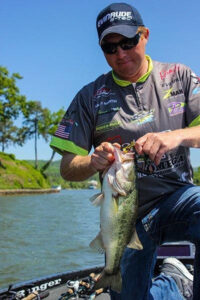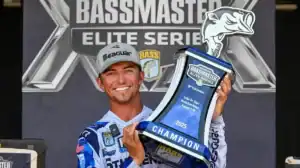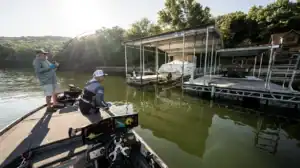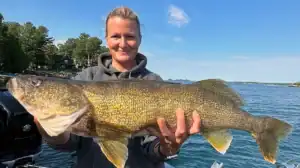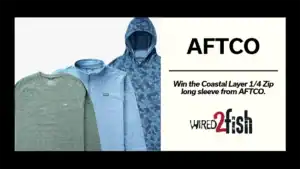Summer bass fishing isn’t always easy. With the increased boat traffic, sweltering heat and obstinate bass, a relaxing day on the water can turn stressful for many anglers. If you’re willing to battle the heat this summer in search of summertime bass, football jigs are very effective fish catchers.
Omega Custom Tackle pro Casey Martin credits much of his summer bass fishing success to football jigs. Although other techniques such as deep diving crankbaits and Carolina rigs can also be productive in warm weather, Martin finds himself relying heavily on football jigs when the money is on the line.
A bulky profile to match larger forage
You always hear top bass fishing pros discussing the importance of “matching the hatch”. It may seem redundant at times, but embracing this philosophy pays huge dividends on the water. Most bass forage spawns and grows throughout the spring, making the football jig’s big profile irresistible to summer bass.
“By the time summer rolls around, bass forage is much bigger than it was in the spring,” Martin said. “Just like more subtle presentations work well in the spring, big profiles dominate throughout the summer. Bass know what natural forage is supposed to look like in all times of the year and a bulky football jig is a great way to imitate their ordinary prey.”
In addition to its resemblance to summer forage, a football jig’s large profile also attracts bass from greater distances in deep water. As light penetration decreases further into the water column, bass can have a hard time honing in on their prey.
“If you throw a lot of small baits in deep water, you’ll have your fair share of short strikes and missed fish,” Martin said. “That doesn’t necessarily mean the bass aren’t feeding well—sometimes they just can’t find it in the dark water. A football jig displaces a lot of water, which bass are able to sense with their lateral lines.”
Most productive areas to throw a football jig
When the water temperature reaches 75 degrees and the bass begin their migration to ledges, deep points and offshore cover, Martin does a lot of damage with a football jig. His decision to use a football jig hinges on 2 key aspects.
“First and foremost, I’m always looking for the presence of bait when I’m throwing a football jig in deep water,” Martin said. “I don’t waste any time fishing areas void of bait. Secondly, but equally important, I’m searching for areas with a hard bottom composition near some sort of depth change.”
Martin favors hard bottom transition areas for a biological reason. Why some believe a hard bottom helps bass pin prey easier, he has a different train of thought.
“Areas with a hard bottom host their own miniature ecosystems,” Martin said. “These areas play host to everything a bass could possibly want—bait, mussels, algae, plankton—it’s like a dinner buffet for bass.”
The proper presentation and hookset
Martin’s dissection of deep water structure and cover always begins with a long cast to cover water efficiently. On most fisheries, he’ll start his presentation by slowly dragging the football jig with his rod to the side, much like he would a Carolina rig, in order to maintain bottom contact for a solid idea of the bottom composition and any key transition areas. His favorite technique, however, is one he’s perfected on multiple Tennessee Valley Authority (TVA) lakes.
“I absolutely love to ‘stroke’ a football jig in the summer,” Martin said. “I’ll give it really quick lift with the rod and let it fall on completely slack line. You’ll either get bit immediately upon jerking the rod or right as it begins to fall. This is a great way to get reaction strikes in deep water and they’ll hammer it.”
A proper hookset is essential when fishing a football jig in the summer. You’ll usually have a good bit of line out when the bass bite, so Martin suggests using a very aggressive hookset—as soon as he reels his slack, he goes to town. The angle of your hookset is important as well. In order to get the hook upward and into the roof of the bass’ mouth, he executes his hooksets at a 45-degree angle.
“Football jig fish are very easy to lose because the bait is very heavy, which allows bass to get a lot of leverage on them when they jump,” Martin said. “To avoid the heartache, do your very best to discourage the fish from jumping. Keep constant tension on them and most importantly, keep your rod tip down. With such a heavy head and no split rings, you don’t stand much of a chance if they jump.”
Trailer, jig and equipment selection is essential
Martin doesn’t get too carried away when selecting trailers for his football jigs. If the bass are actively feeding, he most often uses a large, bulky trailer such as a NetBait Paca Craw or a Zoom Brush Hog. Only when fishing a very clear lake, such as Beaver Lake, will he downsize his trailer.
“When I’m targeting finicky, clear water bass, my go-to trailer is a Yamamoto Double Tail Grub,” Martin said. “Some anglers like to downsize their trailers after cold fronts or when the fishing is tough, but bass don’t just eat small meals after a cold front. Instead of downsizing, I may just fish a bit slower. You can still make them eat.”
When selecting a football jig, Martin exclusively uses an Omega Derek Remitz Football Jig due to its large, EWG hook for long distance hooksets. If he’s targeting water in the 12 to 25-foot range, he opts for the 3/4-ounce model while depths in excess of 25 feet call for the 1-ounce model. Much like his trailer selection, he keeps his color selection very simple.
“More than likely, you’ll find me using the Ozark Special color with a green pumpkin trailer in most situations,” Martin said. “In clear water however, I’ll switch to the PBJ color and a watermelon trailer to achieve a more natural look. If the water is stained, I like to throw the Black Blue color.”
Big football jigs call for stout tackle, prompting Martin to use a 7-foot, 1-inch heavy-action G. Loomis GLX 854C Casting Rod and a 7.1:1 reel. His primary concern, however, is line condition.
“When you’re dragging a big football jig over shell beds and other hard bottom areas, your line can fray very easily,” Martin said. “For this reason, I use 15-pound Seaguar InvizX Fluorocarbon Line. It’s outstanding line, but it’s still a good idea to check it after every 15 casts and fish catch.”
If you’re looking for some hot summer bass fishing action, a football jig is an outstanding option. If you can find the most productive areas, practice the proper presentation and use quality equipment, you’ll catch a lot of bass this summer.

